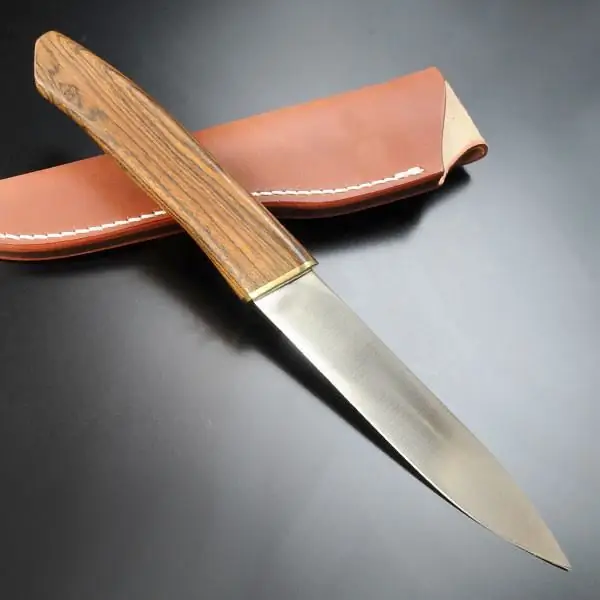2025 Author: Howard Calhoun | [email protected]. Last modified: 2025-01-24 13:10:41
One of the most common and used among stainless materials is steel grade 12X18n10t. The characteristics of the alloy, which we will consider in today's article, contributed to this to a large extent. If we describe the belonging of this composition in full, then here it is necessary to highlight that it contains titanium, but belongs to the austenitic class.
General description of key parameters
So, we can start with the fact that the chemical composition of steel is regulated by the rather old GOST 5632-72. Among the unequivocal advantages of this type of material, high impact strength and high ductility stand out. Since the grade of the alloy belongs to the austenitic class, then, of course, it undergoes heat treatment. This procedure consists in the process of hardening at a temperature of 1050 to 1080 degrees Celsius, followed by cooling the material in water. Carrying out this procedure ensures the achievement of maximum viscosity and plasticity. Strength and hardness of the materialwill be about average.

Another important point is that when working with temperatures up to +600 degrees Celsius, the characteristics of 12x18n10t make it possible to use the alloy as a heat-resistant one. Chromium and nickel are used as the main alloying elements.
Another important property is that single-phase alloys have a stable structure of the austenitic grade with a small amount of titanium carbides. This substance is added in order to avoid such a disadvantage as intergranular corrosion. The strength level of steels belonging to the austenitic and austenitic-ferritic classes does not exceed the limit of 700-850 MPa.
Using steel
Alloy 12x18n10t, which can also be called stainless chromium-nickel steel, can be used in a wide variety of applications. For example, such a composition with varying degrees of strength is successfully used where it is necessary to combine high strength and elastic properties of metal parts operating in an aggressive environment.

Consumer Properties
If we talk about the main consumer properties of this alloy, it is important to note the following. Such characteristics of 12x18n10t as tensile strength, as well as relative elongation, are established with a certain degree of approximation. There are also reference data that do not take into account the hardenability of the metal, which significantly depends on the chemical composition, melting method and those parameters thatwere present before processing.
Specialists recommend using this steel in cases where it is necessary to manufacture welded parts, in dilute solutions of various acids (nitric, phosphoric, etc.). It is also possible to manufacture a variety of parts that can operate in a temperature range from -196 to +600 degrees Celsius under high pressure. It is also worth noting here that if there is a close relationship with any aggressive environment, then the upper temperature limit will drop from 600 to 350 degrees.

Characteristics 12x18n10t. Deciphering markings
So, if we talk about deciphering this class, then, of course, we should start with general concepts. The first thing you see in the title is the numbers. This value shows what is the average carbon content in hundredths of a percent in this composition. If we talk specifically about this alloy, then here this content will be 0.12%. If, for example, only one digit is indicated at the beginning, this means that the amount of carbon rises to tenths of a percent. If the figure is absent at all, then this substance in the material is 1% or more.

Next, consider the letter X and the number 18 together. The letter indicates that the composition contains chromium, and the number shows how much it is in percent. In this case, the Cr content is 18%. It is important to note here that only hundredths or tenths of a percent can be only carbon, and such numbers are only at the beginning. All other characteristics of steel 12x18n10tindicated in full percentages.
Further, everything becomes simple, h10 says that the composition contains 10% nickel. As for the last letter T, it indicates the content of titanium in the alloy. The figure is apparently missing here, which means that the amount is quite small - about 1%. The titanium content cannot exceed 1.5% of the total mass fraction.
To summarize, the characteristics of steel 12x18n10t are as follows: 0.12% carbon, 18% chromium, 10% nickel, a small amount of titanium, which does not exceed 1.5%. All this can be learned only from the name.
How do alloying elements change the structure of an alloy?
Naturally, each of the elements that is added to the composition has its own effect on the final characteristics of stainless steel 12x18n10t.
For example, nickel. The use of this element as an alloying element increases the g - area. However, it is very important to note here that there must be a sufficient amount of it - from 8 to 12% - in order to get the expansion effect. Another important fact is that the addition of this particular substance transforms the alloy into an austenitic class, and this is of key importance. The transition to this class allows you to combine a very high manufacturability of steel and a large number of various performance characteristics. Also, the addition of nickel increases resistance to corrosion and allows the use of steel in those places where there is constant contact with aggressive media (acids).

Strength characteristics Art. 12х18х10t
One of the mostThe most common methods for increasing strength are high-temperature heat treatment (HTHT). In order to investigate the effect of HTMT on this type of steel, workpieces 100 x 100 mm and a length of 2.5 to 5 m were selected. Hardening was carried out on a 350 mill. 1200 degrees. Then they were kept under the influence of the same temperature for 2-3 hours. The steel itself was rolled using conventional rolling technology.
It can be added that steel 12x18n10t is strengthened more than, for example, 08x18n10t, but at the same time, the percentage of softening with increasing temperature is increased. This is due to the different proportions of carbon content.
What's more important to say about the temperature performance is that if the steel is operated at an indicator of 800 degrees, then its maximum operating time is about 10,000 hours.
Recommended:
Food stainless steel: GOST. How to identify food grade stainless steel? What is the difference between food stainless steel and technical stainless steel?

The article talks about grades of food grade stainless steel. Read how to distinguish food stainless steel from technical
Corrosion resistant steel. Steel grades: GOST. Stainless steel - price

Why metal materials break down. What are corrosion-resistant steels and alloys. Chemical composition and classification according to the type of stainless steel microstructure. Factors affecting pricing. Steel grade designation system (GOST requirements). Application area
Steel U8: characteristics, application, interpretation

Today, there are many types of steel. One of them is instrumental. Belonging to this class of material means that the substance contains at least 0.7% carbon. The presence of this component gives certain performance characteristics
Characteristics of steel 65x13: properties, hardness. Reviews about knives made of steel 65x13

In modern metallurgy, a huge number of steels are used. Their characteristics, as well as the variety of nomenclature, are truly immense
440 steel - stainless steel. Steel 440: characteristics

Many people know 440 steel. It has established itself as a reliable, anti-corrosion, time-tested hard material, which is most often used for the manufacture of knives for various purposes. What is the secret of this alloy? What are its chemical, physical characteristics and applications?

